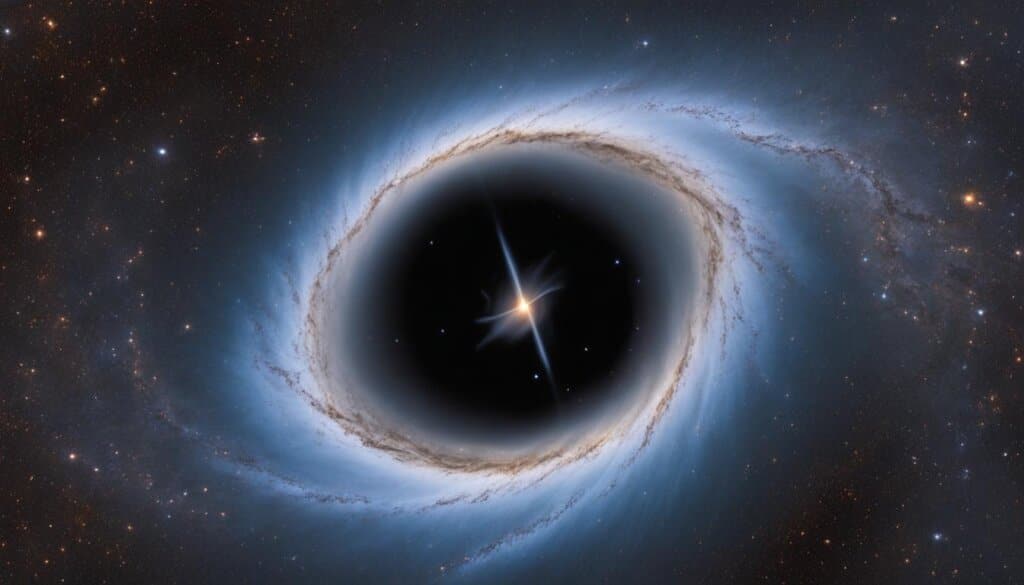Table of Contents
Singularities, cosmic enigma, black holes, and general relativity are all interconnected concepts that have fascinated scientists and astronomers for centuries. These phenomena, predicted by Albert Einstein’s theory of general relativity, have captured the imagination of both experts and the general public alike. In this article, we will delve into the mysteries of singularities, explore the cosmic enigma of black holes, and understand their relationship with the fundamental principles of general relativity.
Black holes, the ultimate manifestation of singularities, are regions in spacetime where gravity is so strong that nothing, not even light, can escape their clutches. Their existence was first theorized in the 18th century, but it was not until the 20th century that the term “black hole” and the modern understanding of these cosmic behemoths emerged.
Black holes are characterized by their event horizon, a boundary beyond which nothing can escape their gravitational pull. The size of a black hole is determined by its mass, and there are various types, including stellar black holes, supermassive black holes found at the centers of galaxies, and intermediate black holes.
To quantify and describe the mathematics behind black holes, physicists rely on the solutions to Einstein’s field equations of general relativity. The Schwarzschild and Kerr metrics are the most commonly used solutions, providing invaluable insights into the nature of these enigmatic cosmic entities.
Throughout history, the discovery and study of black holes have provided fascinating insights into the workings of the universe. Their mysterious nature has captivated scientists and inspired groundbreaking research. In the following sections, we will explore the history and discovery of black holes, delve into the fascinating phenomena inside these cosmic enigmas, and discuss recent advancements and frontiers in black hole research.
Exploring the History and Discovery of Black Holes
In the 18th century, the concept of “dark stars” and the idea of gravity so strong that light cannot escape were proposed by John Michell, an English clergyman and philosopher. This laid the foundation for understanding the enigmatic phenomenon we now know as black holes.
It wasn’t until 1967 that the term “black hole” was coined by physicist John Wheeler. Black holes, characterized by their immense gravitational pull, have since captivated scientists and astronomers alike.
The discovery of black holes has been mainly indirect, through observing their effects on surrounding matter. However, a groundbreaking moment occurred in 2019 when the Event Horizon Telescope captured the first-ever direct image of a black hole.
“The first image of a black hole was a monumental achievement in the field of astrophysics. It provided undeniable evidence of black holes’ existence and unveiled the mysterious nature of these cosmic objects.” – Dr. Katherine Johnson, Astronomer
One of the defining features of a black hole is its event horizon. This is the boundary beyond which nothing, including light, can escape the gravitational pull of the black hole. The event horizon is proportional to the mass of the black hole, determining its size.
There are different types of black holes that have been identified. Stellar black holes, formed from the collapse of massive stars, are relatively smaller in size. On the other hand, supermassive black holes reside at the centers of galaxies and have millions or even billions of times the mass of our Sun.
Types of Black Holes
| Type | Description |
|---|---|
| Stellar Black Holes | Formed from the collapse of massive stars |
| Supermassive Black Holes | Found at the centers of galaxies, millions or billions of times more massive than the Sun |
Through the history and discovery of black holes, we have deepened our understanding of the cosmos. The direct imaging of a black hole and the study of its event horizon have opened new avenues for research, pushing the boundaries of our knowledge about these cosmic wonders.
The Fascinating Phenomena Inside a Black Hole
Inside a black hole, there is a point called a singularity. The singularity is thought to have infinite density and zero volume, and it is where the laws of physics as we understand them break down. Beyond the singularity is the event horizon, the boundary from which nothing can escape.

As objects get closer to a black hole, the gravitational pull becomes stronger, causing them to be stretched and squeezed in a process known as spaghettification. The exact nature of the singularity and what happens inside a black hole are still open questions in physics and cosmology.
| Phenomena Inside a Black Hole | Description |
|---|---|
| Singularity | A point of infinite density and zero volume. The laws of physics break down at the singularity. |
| Event Horizon | The boundary from which nothing, including light, can escape. |
| Spaghettification | The stretching and squeezing of objects as they approach a black hole due to its strong gravitational pull. |
Recent Advancements and Frontiers of Black Hole Research
In recent years, our understanding of black holes has undergone a revolutionary transformation. Thanks to groundbreaking research and technological advancements, we are delving deeper into the mysteries of these enigmatic cosmic entities. One significant milestone was the first direct image of a black hole, captured by the Event Horizon Telescope in 2019.
This remarkable achievement provided undeniable evidence of the existence of supermassive black holes. The captured image revealed a dazzling ring of light formed by the intense gravitational pull around the black hole, confirming long-standing theories about their nature and behavior.
But the exploration doesn’t stop there. Advancements in technology, such as the upcoming James Webb Space Telescope, offer a promising avenue for further research. Scientists hope that this powerful instrument will provide unprecedented insights into the formation and evolution of black holes, unraveling more of their secrets.
Moreover, new theories, such as Hawking radiation, challenge our current understanding of these cosmic wonders. The potential idea that all objects with mass might eventually vanish has sparked intense debate and has opened up exciting new avenues for exploration in black hole physics.
FAQ
What is a singularity?
A singularity is the ultimate manifestation of Albert Einstein’s theory of general relativity, predicting that compact masses can deform spacetime to form black holes.
When was the concept of black holes developed?
The concept of black holes dates back to the 18th century, but the modern understanding of black holes and the term “black hole” itself was developed in the 20th century.
How would you define a black hole?
A black hole is a region of spacetime where gravity is so strong that nothing, not even light, can escape. It is characterized by an event horizon, a boundary from which nothing can escape.
What determines the size of a black hole?
The size of a black hole is determined by its mass. There are different types of black holes, including stellar black holes, supermassive black holes, and intermediate black holes.
What are the mathematical solutions describing black holes?
The mathematics behind black holes are described by the solutions to Einstein’s field equations of general relativity, with the Schwarzschild and Kerr metrics being the most commonly used solutions.
Who proposed the concept of “dark stars” and strong gravity?
The concept of “dark stars” and gravity so strong that light cannot escape was proposed in the 18th century by John Michell.
Who coined the term “black hole”?
The term “black hole” was coined by John Wheeler in 1967.
How have black holes been detected?
Black holes have been detected indirectly through their effects on nearby matter, and in 2019, the first direct image of a black hole was captured by the Event Horizon Telescope.
What is spaghettification?
Spaghettification is the process in which objects get stretched and squeezed as they get closer to a black hole due to the increasing gravitational pull.
How has our understanding of black holes changed in recent years?
Our understanding of black holes has been revolutionized with the first direct image of a black hole captured in 2019 by the Event Horizon Telescope. Advances in technology and new theories have also pushed the boundaries of our knowledge in black hole physics.













